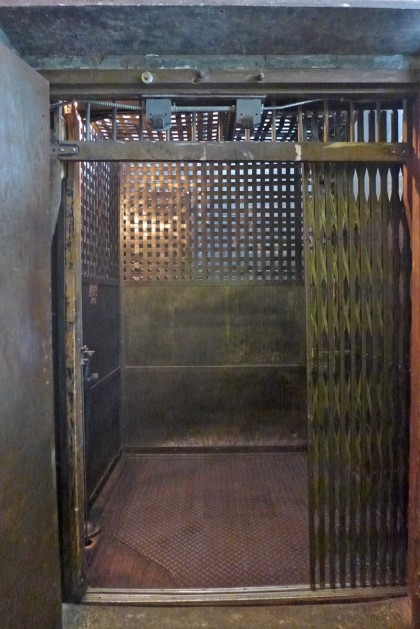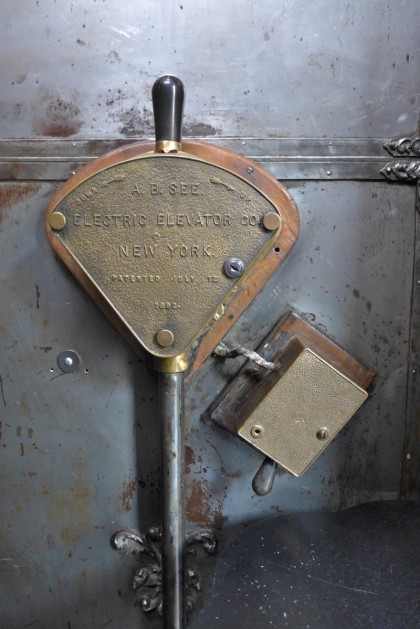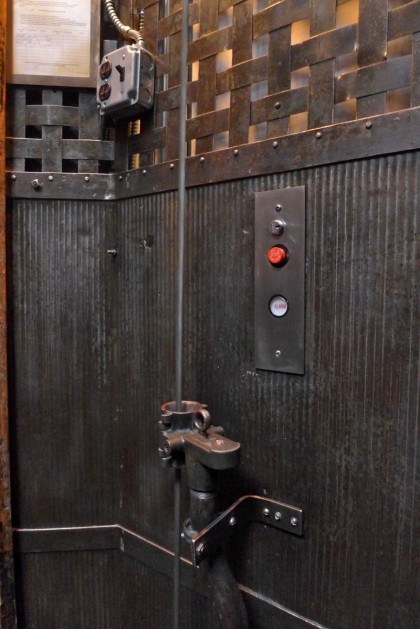The Ups and Downs of Old Tribeca

 About the author: Gardiner Comfort is an actor and teacher who grew up in a loft in Tribeca. He graduated from Brooklyn Friends School, Skidmore College, and then the American Repertory Theater’s Acting Institute at Harvard. He curates a monthly night of new work at the Parkside Lounge on the Lower East Side and finds himself performing in Shakespeare plays more than any other type. He lives with his wife in Harlem.
About the author: Gardiner Comfort is an actor and teacher who grew up in a loft in Tribeca. He graduated from Brooklyn Friends School, Skidmore College, and then the American Repertory Theater’s Acting Institute at Harvard. He curates a monthly night of new work at the Parkside Lounge on the Lower East Side and finds himself performing in Shakespeare plays more than any other type. He lives with his wife in Harlem.
Every kid who grew up downtown in the old days remembers riding in freight elevators. All the old industrial buildings had them: hand-operated, ancient cages that left the brick shaft walls open and the distant vanishing point of the top floor visible as a tiny white sliver of daylight at the end of a dark shaft. They were thoroughly entrancing to children, who would stand with their necks craned and mouths open. The elevators were operated by a lever that was pulled or pushed, just like in any fancy Upper East Side building today, in which a uniformed man delivers his charge to its respective floor. Downtown, of course, the elevators needed no trained expert to operate them. That responsibility usually fell to my parents, or whatever adult was there. Sometimes I was allowed to try it out, but usually with a larger hand over mine, and we switched to a modern, automatic elevator before I was old enough to drive alone.
 The switch was a change, for sure, but it was inevitable. A manual elevator was incredibly inconvenient for a residential building. It needed to be available to building entrants at any time, so if you used it, and left it at your floor, you needed to be in earshot of the call bell for whenever someone arrived who needed access to his floor, so you could go down and pass the thing off. My mother tells me ugly stories of people jerry-rigging the bell so it wouldn’t disturb them when someone called up.
The switch was a change, for sure, but it was inevitable. A manual elevator was incredibly inconvenient for a residential building. It needed to be available to building entrants at any time, so if you used it, and left it at your floor, you needed to be in earshot of the call bell for whenever someone arrived who needed access to his floor, so you could go down and pass the thing off. My mother tells me ugly stories of people jerry-rigging the bell so it wouldn’t disturb them when someone called up.
And then there were the breakdowns. I don’t know how old our elevator was, but it would occasionally peter out midway up, leaving someone to scream for assistance, which was never quick to arrive. I remember one huge Christmas party, when one of my parents’ guests got stuck. The attendees who were aware of the problem watched with wonder as someone bravely scaled his way down to retrieve the trapped guests, who eventually arrived, a little shaken, for drinks and dancing.
I was 9 or 10 years old when the new elevator was installed, and it made me nervous. I remember telling my mom over the intercom that I’d be taking the stairs.
 In retrospect, though, our old elevator was light years ahead of others. I’ll never forget a certain type I used to ride in. It had thick, metal cables running the length of the elevator shaft and passing right through the elevator. After you got in and slid the gate shut, you yanked on the cable as hard as you could in one direction; the elevator would magically start and move up, while the massive, threaded length of steel traveled through holes in the roof and floor. When you got to your floor, you pulled in the opposite direction and everything jolted to a stop. These were rare even in the eighties, but I know a building across the street from my parents’, where the Issey Miyake store is and where the Commodities health food store used to be, that still has one. According to the super there, it’s one of eight left in the city and it gets serviced once a month to be safe. When I learned this, I imagined what the co-op meetings must be like, with a new vote taken every year to determine the fate of this relic—this elevator that is, in all honesty, completely inefficient. In my mind I saw a cluster of people sitting in a loft, eating hors d’oeuvres, and tensely discussing the issues of the building. (I remember being a child and listening when my parents hosted their co-op meetings. Increasingly, they seemed like parties where everyone mistrusted each other.) They would have discussed new hallway lighting and replacing the old, industrial front door or the dilapidated mailboxes. The old timers would clench their teeth as the newcomers complained about the appearance of the lobby floors. But by the end, despite the disagreements and tensions, and although the cost must’ve been exorbitant, the elevator survived.
In retrospect, though, our old elevator was light years ahead of others. I’ll never forget a certain type I used to ride in. It had thick, metal cables running the length of the elevator shaft and passing right through the elevator. After you got in and slid the gate shut, you yanked on the cable as hard as you could in one direction; the elevator would magically start and move up, while the massive, threaded length of steel traveled through holes in the roof and floor. When you got to your floor, you pulled in the opposite direction and everything jolted to a stop. These were rare even in the eighties, but I know a building across the street from my parents’, where the Issey Miyake store is and where the Commodities health food store used to be, that still has one. According to the super there, it’s one of eight left in the city and it gets serviced once a month to be safe. When I learned this, I imagined what the co-op meetings must be like, with a new vote taken every year to determine the fate of this relic—this elevator that is, in all honesty, completely inefficient. In my mind I saw a cluster of people sitting in a loft, eating hors d’oeuvres, and tensely discussing the issues of the building. (I remember being a child and listening when my parents hosted their co-op meetings. Increasingly, they seemed like parties where everyone mistrusted each other.) They would have discussed new hallway lighting and replacing the old, industrial front door or the dilapidated mailboxes. The old timers would clench their teeth as the newcomers complained about the appearance of the lobby floors. But by the end, despite the disagreements and tensions, and although the cost must’ve been exorbitant, the elevator survived.
In my parents’ building, no one was willing to stand up for the freight elevator. It was dismantled and removed and replaced with a modern, push-button operation. On its maiden voyage, the building threw a party in it, going floor to floor, with Champagne for all.
About the photos: Thanks to artist Grimanesa Amorós, who indulged my request to shoot the two elevators at 54 N. Moore—I’ll share more photos in a follow-up post.* Amorós, as you might already know, also created the fabulous “Terrarium” light installation in the building’s lobby.
*••• Elevator #1
••• Elevator #2













Lived in a building in Soho for 5 years with “this elevator”….very cool looking but a pain in the A!
The elevator in my building on Beach Street was a freight elevator that could probably fit a car in it. My building was once a furniture warehouse & the elevator was a 3 sided cage with the front open & a cable which we pulled up to go down & down to go up. It was always a challenge to stop it exactly on your floor, sometimes it was a few inches above your floor & then you would try to get it level & would land a few inches below your floor. There were 2 huge metal doors that you opened by pulling on a rod. When my kids were babies I would wheel the crib into the elevator & take it up to my neighbor who would babysit so we could have a night out. My building went condo 7 years ago & a small passenger elevator was installed with buttons & a fob to unlock it on your floor.
Well, well, I do tell.
Our building still has “this elevator” as well as an old street elevator.
Our children were babies/toddlers when we moved here and now we’re grandparents.